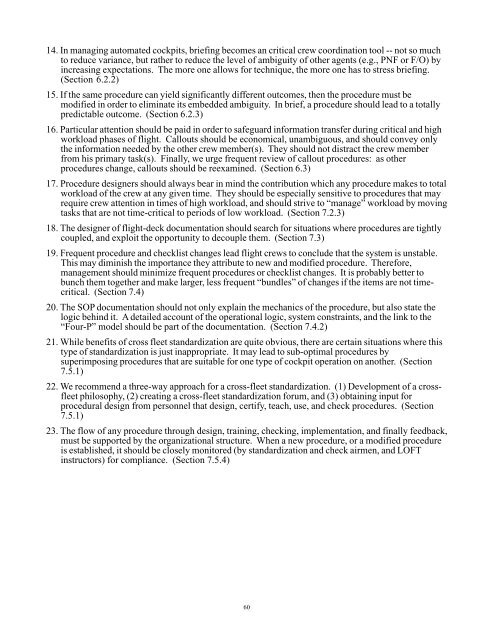On the Design of Flight-Deck Procedures - Intelligent Systems ...
On the Design of Flight-Deck Procedures - Intelligent Systems ...
On the Design of Flight-Deck Procedures - Intelligent Systems ...
You also want an ePaper? Increase the reach of your titles
YUMPU automatically turns print PDFs into web optimized ePapers that Google loves.
14. In managing automated cockpits, briefing becomes an critical crew coordination tool -- not so muchto reduce variance, but ra<strong>the</strong>r to reduce <strong>the</strong> level <strong>of</strong> ambiguity <strong>of</strong> o<strong>the</strong>r agents (e.g., PNF or F/O) byincreasing expectations. The more one allows for technique, <strong>the</strong> more one has to stress briefing.(Section 6.2.2)15. If <strong>the</strong> same procedure can yield significantly different outcomes, <strong>the</strong>n <strong>the</strong> procedure must bemodified in order to eliminate its embedded ambiguity. In brief, a procedure should lead to a totallypredictable outcome. (Section 6.2.3)16. Particular attention should be paid in order to safeguard information transfer during critical and highworkload phases <strong>of</strong> flight. Callouts should be economical, unambiguous, and should convey only<strong>the</strong> information needed by <strong>the</strong> o<strong>the</strong>r crew member(s). They should not distract <strong>the</strong> crew memberfrom his primary task(s). Finally, we urge frequent review <strong>of</strong> callout procedures: as o<strong>the</strong>rprocedures change, callouts should be reexamined. (Section 6.3)17. Procedure designers should always bear in mind <strong>the</strong> contribution which any procedure makes to totalworkload <strong>of</strong> <strong>the</strong> crew at any given time. They should be especially sensitive to procedures that mayrequire crew attention in times <strong>of</strong> high workload, and should strive to “manage” workload by movingtasks that are not time-critical to periods <strong>of</strong> low workload. (Section 7.2.3)18. The designer <strong>of</strong> flight-deck documentation should search for situations where procedures are tightlycoupled, and exploit <strong>the</strong> opportunity to decouple <strong>the</strong>m. (Section 7.3)19. Frequent procedure and checklist changes lead flight crews to conclude that <strong>the</strong> system is unstable.This may diminish <strong>the</strong> importance <strong>the</strong>y attribute to new and modified procedure. Therefore,management should minimize frequent procedures or checklist changes. It is probably better tobunch <strong>the</strong>m toge<strong>the</strong>r and make larger, less frequent “bundles” <strong>of</strong> changes if <strong>the</strong> items are not timecritical.(Section 7.4)20. The SOP documentation should not only explain <strong>the</strong> mechanics <strong>of</strong> <strong>the</strong> procedure, but also state <strong>the</strong>logic behind it. A detailed account <strong>of</strong> <strong>the</strong> operational logic, system constraints, and <strong>the</strong> link to <strong>the</strong>“Four-P” model should be part <strong>of</strong> <strong>the</strong> documentation. (Section 7.4.2)21. While benefits <strong>of</strong> cross fleet standardization are quite obvious, <strong>the</strong>re are certain situations where thistype <strong>of</strong> standardization is just inappropriate. It may lead to sub-optimal procedures bysuperimposing procedures that are suitable for one type <strong>of</strong> cockpit operation on ano<strong>the</strong>r. (Section7.5.1)22. We recommend a three-way approach for a cross-fleet standardization. (1) Development <strong>of</strong> a crossfleetphilosophy, (2) creating a cross-fleet standardization forum, and (3) obtaining input forprocedural design from personnel that design, certify, teach, use, and check procedures. (Section7.5.1)23. The flow <strong>of</strong> any procedure through design, training, checking, implementation, and finally feedback,must be supported by <strong>the</strong> organizational structure. When a new procedure, or a modified procedureis established, it should be closely monitored (by standardization and check airmen, and LOFTinstructors) for compliance. (Section 7.5.4)60
















